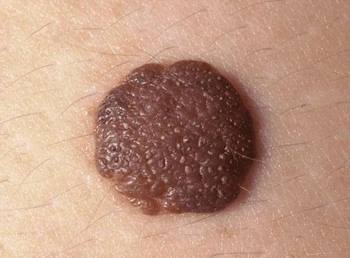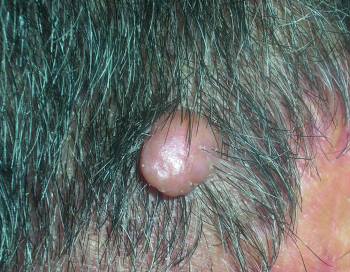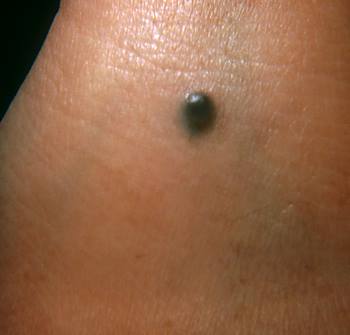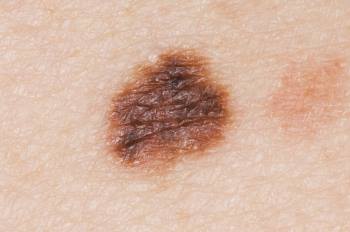
Birthmarks are usually dark skin growths that develop from the pigment-producing cells of the skin (melanocytes).
- Many people have some moles, but the tendency to develop atypical moles can sometimes be hereditary.
- Birthmarks and atypical birthmarks that show a significant change should be examined using a biopsy to rule out melanoma.
- Most non-cancerous (benign) birthmarks do not require treatment, but annoying or cosmetic undesirable birthmarks can be removed with a scalpel under local anesthesia.
(See also Benign Skin Tumors – An Overview .)
Birthmarks can be of different sizes. This varies from small dots to 2.5 centimeters in diameter. Usually the diameter is less than one centimeter, often even less than 6 millimeters. Almost everyone has some birthmarks, many of them are very large. People with more than 50 birthmarks have a slightly increased risk of melanoma , i.e. H. cancerous (malignant) growths of melanocytes. You should monitor yourself for changes in your birthmarks (see ABCDE of melanoma ) and also have them checked regularly by your family doctor.
Birthmarks (nevi) can be flat or raised, smooth or rough (wart-like), and hair can grow on them. They vary in color from skin-colored, yellow, brown, blue-gray to almost black. At the beginning they can be red, but often darken later.birthmarks




They generally develop in childhood or adolescence, and existing birthmarks grow larger and darker over time (proportional to body growth). For some people, birthmarks do not stop developing for a lifetime. Birthmarks can appear anywhere on the body. They respond to changes in hormone levels and become darker during pregnancy. Once moles are created, they are preserved for life. Over time, they lose some pigmentation, become a little more sublime and fleshy. In light-skinned people, birthmarks appear preferentially on sun-exposed skin areas.
Did you know …
| Birthmarks get darker during pregnancy. |
diagnosis
- Examination of the skin
- ABCDE of melanoma
- Sometimes biopsy
Birthmarks can easily be identified by their typical appearance. They are symmetrical, round or oval and have regular contours. Birthmarks do not itch and pain, and they are not a form of cancer. However, some develop or look similar to melanoma . In fact, many melanomas arise from birthmarks, which is why a look that is somehow suspicious should be removed and examined microscopically ( biopsy ).
The following changes in a birthmark can be warning signals for melanoma (also called “ABCDE of melanoma”):
- A: Asymmetry – asymmetrical appearance (i.e., one half looks different from the other)
- B: Boundary – irregular contours (i.e., the edges are blurred or serrated rather than clearly defined and smooth)
- C: Color – change the color of an existing paint or a color that is significantly darker than a person’s other paint.
- D: diameter – more than 6 millimeters, about the size of a pencil eraser.
- E: Development – a new time for a person over 30 or a changing time
If birthmarks become painful, itchy or bleed, develop skin damage or any signs of melanoma, doctors can perform a biopsy. If it turns out that a birthmark is carcinogenic, additional intervention may be necessary to remove the surrounding skin.
treatment
- Occasionally removal
Most birthmarks are harmless and do not need to be removed. Depending on their appearance and fit, some of them are even considered a beauty mark.
Ordinary birthmarks or nevi that are unattractive or where the clothing irritates them can be removed with local anesthesia.
You have atypical birthmarks
(Dysplastic nevi)
Atypical birthmarks are non-cancerous (benign) birthmarks , which have a conspicuous appearance in comparison to normal birthmarks.
People with atypical birthmarks are at increased risk of developing melanoma , i.e. H. a cancer of the pigment-producing cells of the skin called melanocytes. The risk of developing melanoma increases with the increasing number of birthmarks. The risk is also increased for people who spend a lot of time in the sun.
The tendency to develop an atypical birthmark can be hereditary, such as in familial atypical multiple birthmark and melanoma syndromes. With this disorder, two or more first-degree relatives (such as parents, siblings, or children) have many atypical birthmarks and melanomas, and their relatives’ risk of developing melanoma is 25 times higher.
symptoms
Atypical birthmarks tend to be multicolored, usually in shades of brown and bronze with a pink background. They are asymmetrical and have irregular shapes and contours. They are often larger than most normal birthmarks (more than 6 millimeters wide). Atypical birthmarks most often occur on sun-exposed skin areas, but can also occur in covered areas (on the buttocks, breasts or scalp).Atypical birthmark

DR.P. MARAZZI / SCIENCE PHOTO LIBRARY
diagnosis
- Physical examination
- biopsy
People who have had melanoma in their family should have their skin examined by a dermatologist (a doctor who specializes in skin diseases) and find out about signs of melanoma. Even people who already had melanoma should have their skin checked regularly by a dermatologist.
Some dermatologists use a hand instrument (a procedure called dermoscopy) to examine the skin to examine structures on the mole that are not visible to the naked eye and could indicate the likelihood of melanoma.
The dermatologist can remove some atypical birthmarks and examine them under a microscope ( biopsy ).
prevention
- self-examination
- Photographing the birthmarks
- sun protection
People with atypical birthmarks should regularly check for new birthmarks and changes in existing birthmarks that could indicate melanoma. In order to be able to monitor such changes more easily, they or their dermatologist can take color photos. Atypical birthmarks that show a change are sometimes removed.
Skin damage caused by ultraviolet (UV) radiation in sunlight is the cause of melanoma; sun exposure and sunburn in leisure time are crucial. In order to limit damage caused by UV radiation, you should stay in the sun during midday (approx. 10 until 4 p.m.Avoid if possible, wear sun protection clothing , use a broad spectrum sunscreen (one that protects against UV-A and UV-B radiation) and refresh it regularly. People who severely limit their exposure to the sun may need to take vitamin D supplements.
treatment
- Occasionally removal
Individuals with atypical birthmarks or a new or changing birthmark should consult a dermatologist to see if the birthmark should be removed. Removal of all atypical birthmarks does not prevent melanoma.